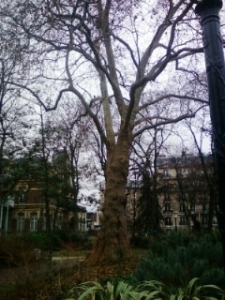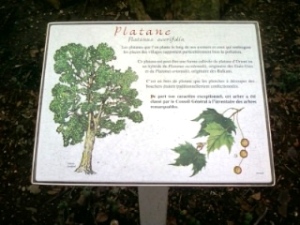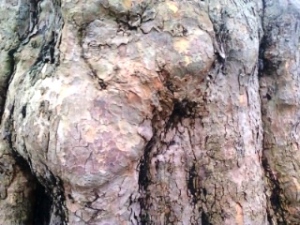A Plane Tree in Paris.
Paris has a close relationship to trees far beyond the scope of understanding to similar aged cities of equivalent size and importance.
The vast woodlands surrounding the expanding Paris boundaries have expanded outwards as the city grew. The trees felled to make way for the spreading City have left behind a legacy of a sylvan horizon. And whilst remnants of the great forests cannot survive within the conurbation, the designers of the City and its banlieue have strived to ensure green space and trees thrive throughout.
There exists a national psyche in France, (post revolution), that green space and its accessibility to all is an essential and given state provision. The 'Mairies' take this very seriously and what was once an ungoverned challenge in providing the best urban green spaces has led into serious competition with exceptional accolades and funding to be won.
This trait has certainly produced some of the most prestigious and carefully managed urban tree planting in the world and the resulting arboreal attractions of Paris turn the head as readily as the architectural splendours or the ‘mini jupes’ trotting by.
It can be argued that with a rapidly changing demography combined with serious economic crisis has resulted in a diminishing emphasis on the care and maintenance of French urban green space in very recent times. At a time when many other European cities are struggling to justify the immediate (or long term) funding to green spaces and in particular urban trees are actually facing considerable lobby and pressure from a changing public attitude who are increasingly aware of the benefits in green space.
But it remains that the Paris urban landscape is a ‘tree’ influenced horizon and will remain as such. Paris urban forestry has been through several stages of development and the chosen species through history display a time line parallel to scientific advances in silvicultural biology. In modern history the primary choices have led from Elm’s then Horse Chestnut and now predominantly the Plane tree, Platanus sp.
The scientific attributes for the Plane in a post industrial city make it the obligatory 20th century urban tree.
We are and have been in a new transition of urban tree choice, the current trend being a mix of trees. This reflects post WWII architectural development, which allowed individualistic styles to appear in abundance and thus newer urban tree planting follows suit as the Planes become of an age for renewal. From Trachycarpus palm trees through to groupings of Birch, any recognised restrictions have been lifted allowing designers and landscape architecture freedom to wildly experiment with many tree species.
A value placed on an urban tree (particularly in Europe), is always assessed by its landscape or amenity value – the placement and existence by design and the valuation systems which are used are of a strength to enable the subsequent valuation to be a recognised value in legal and insurance terms. Whilst some reference back to ecological, environmental and other factors are often mentioned, they are still not formally recognised, which allows for a diminishment in responsibility in management of specific specimens in many circumstances. Certainly in the UK, despite many constraints and recognition nationally the care of a urban tree in both private and public ownership is a postcode lottery.
With many urban children growing up in a world where nature has been completely placed in human hands the form of a tree as it grows is the single accessible visible demonstration of natures design.
'This blog is taken from the urban tree valuation on the europeantrees website and is part of a dual valuation for Rural and Urban trees for the Tree Year project 2011. '












Comments